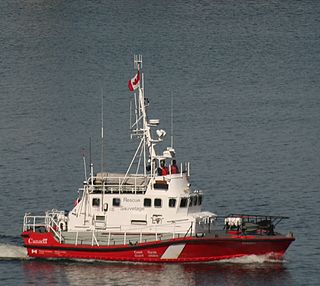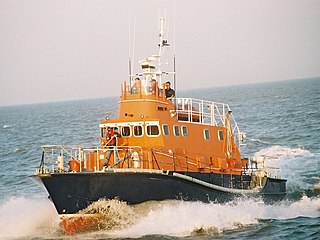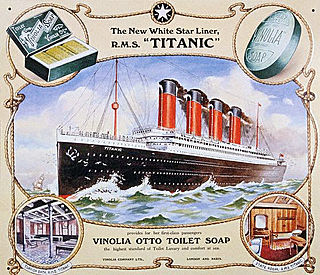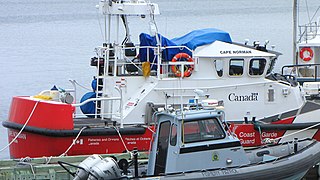
The Canadian Coast Guard is the coast guard of Canada. Formed in 1962, the coast guard is tasked with marine search and rescue (SAR), communication, navigation, and transportation issues in Canadian waters, such as navigation aids and icebreaking, marine pollution response, and support for other Canadian government initiatives. The coast guard operates 119 vessels of varying sizes and 23 helicopters, along with a variety of smaller craft. The CCG is headquartered in Ottawa, Ontario, and is a special operating agency within Fisheries and Oceans Canada.

CCGS Westport is a Canadian Coast Guard search and rescue vessel homeported in Westport, Nova Scotia.

The Arun-class lifeboat was a fast all-weather lifeboat designed by the Royal National Lifeboat Institution (RNLI) for service at its stations around the coasts of the United Kingdom and Ireland. They were operated by the RNLI between 1971 and 2008. Many have been sold to see further service in the lifeboat and coastguard services of other countries.

A lifeboat or liferaft is a small, rigid or inflatable boat carried for emergency evacuation in the event of a disaster aboard a ship. Lifeboat drills are required by law on larger commercial ships. Rafts (liferafts) are also used. In the military, a lifeboat may double as a whaleboat, dinghy, or gig. The ship's tenders of cruise ships often double as lifeboats. Recreational sailors usually carry inflatable liferafts, though a few prefer small proactive lifeboats that are harder to sink and can be sailed to safety.

Coast Guard Motor Lifeboat CG-36500 is a historic, 36-foot lifeboat that is berthed at Rock Harbor in Orleans, Massachusetts. Built in 1946, it is notable for its involvement in the 1952 SS Pendleton rescue, one of the most daring such events recorded in the history of the United States Coast Guard. It was listed on the National Register of Historic Places in 2005, and now serves as a museum boat.

The sinking of the RMS Titanic resulted in the following changes in maritime policy:
A rescue lifeboat is a boat rescue craft which is used to attend a vessel in distress, or its survivors, to rescue crew and passengers. It can be hand pulled, sail powered or powered by an engine. Lifeboats may be rigid, inflatable or rigid-inflatable combination-hulled vessels.

The Canadian Coast Guard (CCG) maintains a fleet of 14.6 m Cape-class motor lifeboats based on a motor lifeboat design used by the United States Coast Guard. In September 2009 the CCG announced plans to add five new lifeboats, bringing the total number of Cape-class lifeboats to 36.

The Canadian Coast Guard has had two motor lifeboats named CCGS Clarks Harbour. The first was a 13-metre (43 ft) vessel, which entered service in 1996.

CCGS Cape Discovery is one of the Canadian Coast Guard's 36 Cape-class motor lifeboats.` She is stationed at Goderich, Ontario. At the vessel's official christening, on June 10, 2006, the Minister of Fisheries and Oceans Canada, Loyola Hearn, said: "Having this state-of-the-art vessel for our personnel provides them with greater safety, as they aid those in distress -- very often in conditions that put their own lives at risk. With the cutter Cape Discovery, we are well positioned to respond to emergency calls, twenty-four hours a day, seven days a week."

CCGS Cape Norman is one of the Canadian Coast Guard's 36 Cape-class motor lifeboats. She and a sister vessel, CCGS Cape Fox, serve the northern coast of Newfoundland. Her home port is Port aux Choix. She and Cape Fox were built in 2002 at Victoria Shipyards, Victoria, British Columbia. The two vessels were shipped from Vancouver to New York City aboard another vessel, where they proceeded under their own power.

CCGS Cape Fox is one of the Canadian Coast Guard's 36 Cape-class motor lifeboats. She and a sister vessel, CCGS Cape Norman, serve the northern coast of Newfoundland. Her home port is Lark Harbour.

The 44-foot motor lifeboat was the standard workhorse of the United States Coast Guard (USCG) rescue boat fleet. The 44′ MLB has been replaced by the 47′ MLB. The boats are powered by twin diesel engines, each powering a separate propeller. The propellers are protected by the hull to help prevent them being damaged if the boat runs aground. The boats have air-tight compartments forward and aft of the steering station. The aft compartment is designed to hold litters to strap in injured people, while the forward compartment holds uninjured rescued.

The United States Coast Guard no longer operates four 52-foot Motor Lifeboats (MLBs), which supplement its fleet of 227 47-foot Motor Lifeboats. These vessels were built in the late 1950s and early 1960s, and displace 32 tons. The four vessels are all stationed in the Pacific Northwest.

Liana's Ransom is a pirate-themed party vessel, operated from Nova Scotia.
The Bay Class Lifeboat is a Robert Allan Ltd. modification of the shorter Royal National Lifeboat Institution's Severn-class lifeboat to meet the needs of the Canadian Coast Guard for off-shore search and rescue operations in severe conditions. They are referred to as the Bay class as each one is named after a Canadian bay.

The United States Coast Guard's series of motor lifeboats included a class of 36 foot motor lifeboats. The Coast Guard built the first of version these vessels in 1929, and retired the last active version, in 1987 as they were replaced by the 44 foot Steel Hull Motor Lifeboat. CG 36500 was retired from active service in 1968, and has since been restored and preserved as a floating museum. These vessels are remembered for the daring rescues Coast Guard seamen performed, using them.

The Motor Lifeboat Triumph was a motor lifeboat operated by the United States Coast Guard. The Triumph, and her sister, the Invincible, were the only vessels in their class. They were built in 1935, when the Coast Guard's other motor lifeboats were 36 foot motor lifeboat—vessels with a shorter range, that did not need facilities for sleeping or the preparation of meals. She could carry sixty rescued people.

CCGS Cape Spry is a Cape-class lifeboat in the Canadian Coast Guard Service, stationed at Souris, Prince Edward Island.














